Croton at home
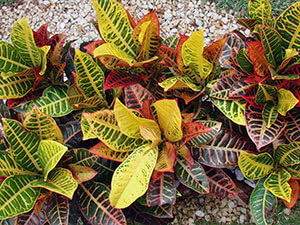 Croton plant (lat. Croton), or codiaeum (lat. Codiaeum), or rushfoil, belongs to the genus in the family Euphorbiaceae. The gardeners liked the name “croton” more than the scientific “codiaeum” that means “head” in Greek. But what does ”croton” mean? Well, no one knows for sure. Perhaps, this name came from the name of the city in southern Italy, where Pythagoras once founded his school, and probably in some dialect this word means “shrub”. The homeland of wild croton is the islands of the Pacific and Northern Australia, India, as well as the Southeast Asia.
Croton plant (lat. Croton), or codiaeum (lat. Codiaeum), or rushfoil, belongs to the genus in the family Euphorbiaceae. The gardeners liked the name “croton” more than the scientific “codiaeum” that means “head” in Greek. But what does ”croton” mean? Well, no one knows for sure. Perhaps, this name came from the name of the city in southern Italy, where Pythagoras once founded his school, and probably in some dialect this word means “shrub”. The homeland of wild croton is the islands of the Pacific and Northern Australia, India, as well as the Southeast Asia.
According to various sources, the number of species in the genus varies from 17 to 1,200, but in indoor horticulture croton flowers are represented only by variegated croton and its hybrids. Croton flower is one of the most beautiful ornamental-deciduous houseplants that serves as a beautiful decoration of the interior and, as a rule, does not take too much space. In some countries, the indoor croton plant is considered to be the keeper of the home, protecting the house from bad energy.
Croton flower – requirements for growing
Indoor croton flower is a bush with leathery leaves of various forms: asymmetric, oblong-lanceolate, pointed or blunt, entire, three-lobed, sinuate, broad-ovate, etc. Young leaves usually have light yellow-green color, gradually they become greener and burgundy, so your indoor croton flower is colored like an autumn forest. A common feature of the leaves of all species and varieties is a distinct venation. Probably, you will not admire flowering croton as its flowers are drooping axillary racemose inflorescences of plain cream color.

Indoor croton flower has achieved the fame as one of the most capricious plants. What are the special features of care for croton?
- Croton sap is toxic. It causes diarrhea, vomiting, contact dermatitis, so all work with croton should be done with gloves.
- Croton at home needs not only spraying of the leaves, but also wiping with a damp sponge. In summer, you should monthly arrange a warm shower for croton.
- Croton does not tolerate watering with cold water and drafts!
- Sometimes at the beginning of the growing season the leaves of croton get strange shapes. Nobody knows what the reason is, but croton has a high degree of mutability that has consequently resulted in creation of a great number of varieties and hybrid forms of this plant, and they differ only in the way a leaf of this or that variety of croton looks.
- Plain-looking flowering of croton takes a lot of energy from the plant, and if you are not going to engage in breeding experiments, it is better to remove flower buds or flower stalks immediately.
Care for croton at home
How to care for croton
Croton loves a bright light, but direct sunlight is preferable only in the morning or before sunset, so in summer it should be kept on the northern window-sill, and in winter, when the sun shines but does not heat, it can be placed on the southern window-sill. If in summer you have the opportunity to keep croton outside and arrange bright diffused light, do not neglect it. The most comfortable temperature for croton in summer is 68-72 ºF, in winter it should be no lower than 61 ºF.

As to watering, the soil clod should be constantly kept slightly moist, but at the same time, you should avoid water stagnation in the roots that can cause decay. Water for irrigation should not be cold, and what is the most important is that it should be filtered or at least sedimented. Air humidity is very important for croton, so you will have to regularly spray or wipe the leaves with a damp washcloth, and in summer you should arrange a warm shower once a month, but without water getting into the pot.

Croton is fertilized with a solution of combined mineral fertilizers applied on the pre-moistened soil from April to November twice a month. In winter fertilizers are used only once a month. To form a beautiful leafage you should prune croton if it is an adult plant, or pinch it if it is a young croton. You should pinch the plants that have reached 6 inches in height, and then pinch the shoots every time when they are 8 inches long. After pruning, the cuts of adult plants should be treated with sulfuric or charcoal powder. Flower buds or young peduncles should be removed, because flowering that does not have any ornamental value wears out croton, and this affects the health and beauty of its leaves.
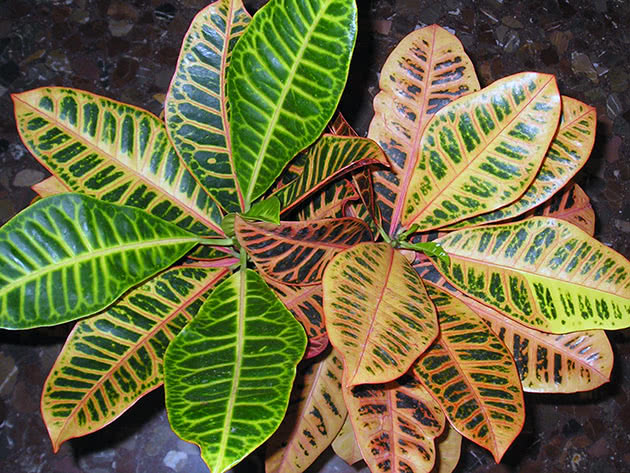
Croton transplanting
Small young crotones are transplanted twice a year. Adult plants are transplanted once every two years. Each new pot should be 0.8 inch bigger in diameter than the previous one. When your croton takes a pot of 10 inches in diameter, it will be its last repotting, but later on you will have to remove the topsoil from the pot every year and replace it with a fresh substrate. The soil for croton should be approximately the following: turf, peat, leaf soil and river sand in equal parts. When transplanting, it is advisable not to break the soil clod of croton, but simply transfer it from the old pot into a new container with a drainage layer of about a quarter of the pot volume.
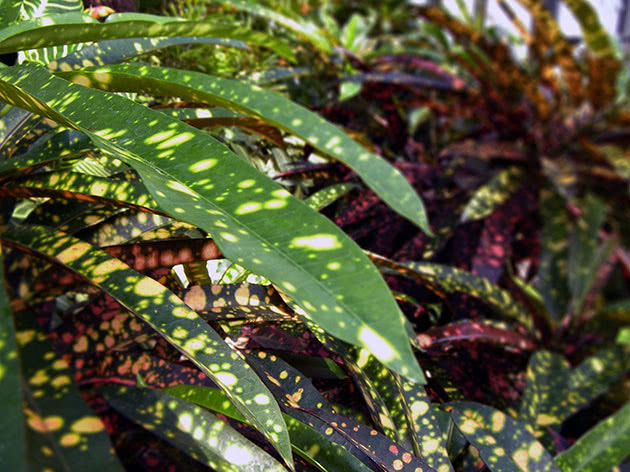
Croton in winter
When the cold season comes, croton is taken away from the northern window-sill and placed on the southern window-sill. Watering should be reduced, but the principal remains the same: the soil must be slightly moist. You should keep on water procedures – spraying and wiping the leaves with a damp sponge, but do not do it as often as in a warm season, and it's better to forget about the shower until summer. You should feed croton no more than once a month, but some professionals are sure that in winter croton does not need feeding at all.
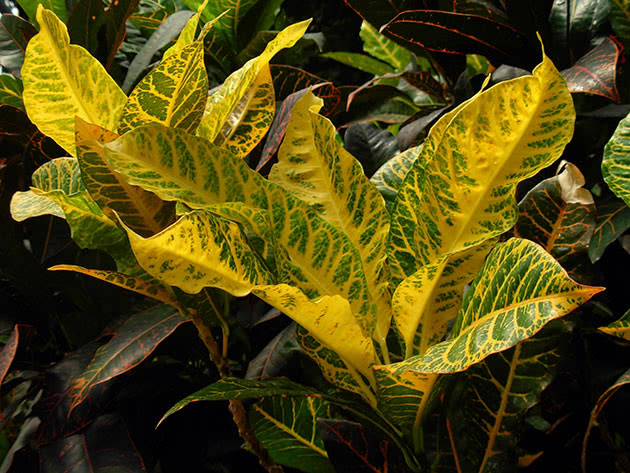
Croton propagation
Propagation of croton by seeds
At home croton can be propagated by stem or leaf cuttings, or by seeds if hybrids are cultivated. Croton seeds quickly lose their germination capacity, so you need to sow freshly harvested seeds. It should also be noted that the germination process takes a long time, and what is the most important is that usually the varietal characteristics are not preserved with generative propagation. Before planting, large croton seeds should be kept in a warm water at a temperature of 140 ºF for half an hour and leave them for a day for swelling. Sowing is carried out at a depth of 0.4 inch, the temperature necessary for seed germination is 72 ºF. The soil in the container with seeds is moistened through the bottom watering until the shoots appear. When the third leaf appears, the seedlings are planted in separate pots with a diameter of 3 inches and are cared as an adult croton.
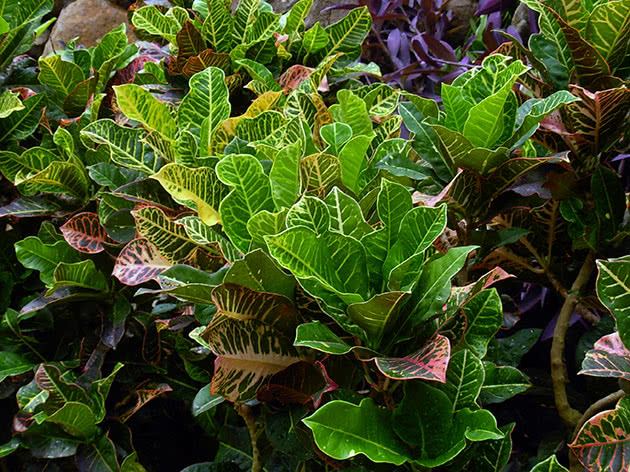
Vegetative way of croton propagation
How to propagate croton by cuttings? The easiest way is to root the apical cutting 2.3-4 inches long, but if you need several cuttings, then the shoot is cut into pieces so that the cuttings have at least one internode with one healthy leaf. The lignified or semi-lignified cuttings are the best for rooting. The poisonous milky sap that bleeds from the cuts should be rinsed off, and then let the slices dry in the air for three hours. The leaves on the upper part of the apical cutting are shortened in parallel to the veins in half. The leaves on the lower part are removed. The cut of the cutting should be dry and processed with a root hormone. Then the cuttings are placed in a container with water heated to 73-86 ºF (to avoid decay of the planting material), and placed to grow roots under bright diffused light. When the stem roots are 0.8 inch long, the seedlings are transplanted into the substrate for croton. For transplanted seedlings it is necessary to arrange a high humidity by frequent spraying during the first ten days after repotting. The sign that the cuttings have taken roots is restoring of the leaf elasticity.

Pests and diseases of croton
Insects of croton
Croton can be attacked by mealybugs, nematodes, scales and spider mites, and mostly it is affected by mites. What makes croton so attractive for them is difficult to say, but sometimes the struggle with them extremely irritates the owner of the flower, and in despair he just throws out the croton. But let us remind you that if you comply with all the rules of care, neither insects nor diseases are dangerous for your plants, and the appearance of mites is explained by the fact that croton is rarely washed and irregularly watered, so you can blame only yourself. To fight with spider mites, mealybugs and scales, you should process the ground parts of croton with a soapy tobacco solution that should be rinsed off in an hour and a half to prevent getting it into the substrate.
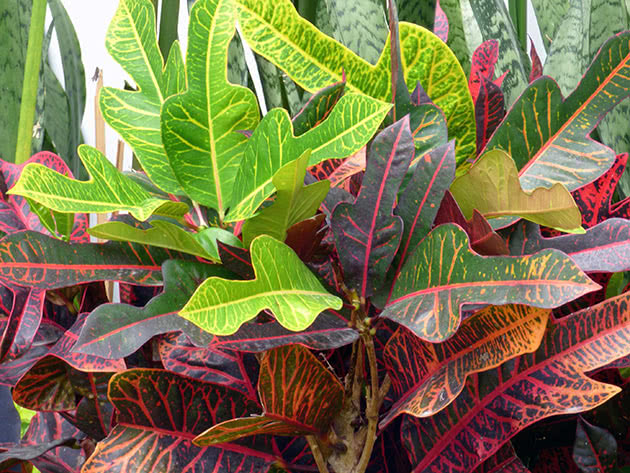
Croton lowered the leaves
If the plant has lowered the leaves, it means it can not drink. It happens if the roots are cold. Rearrange the plant in a warm, bright place, regulate the moistening regime, letting the soil clod dry out a few inches deep between waterings, stop feeding the plant, spray the leaves well and put a transparent plastic bag or cap on the plant.

Croton dries
If only lower leaves of croton are drying, then there is no need to worry: the gradual denudation of the lower part of the stem is a natural process for croton. The dry tips of the leaves indicate that the plant suffers from a low air humidity, and for croton a comfortable moisture index is 70%. If the edges of the leaves dry and brown spots appear on them, then the room is not warm enough and the croton is cold. If the croton leaves not only dry, but also fall off, then its roots definitely lack moisture.
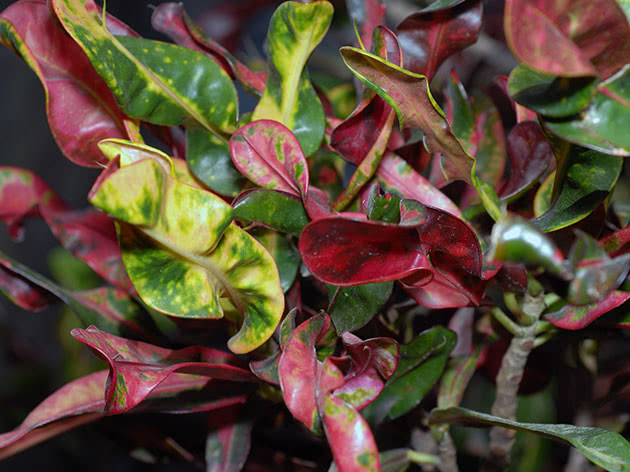
Croton drops leaves
Often the readers of the site ask why the croton leaves are falling off. The first two reasons we have already mentioned are chronically insufficient watering and low air humidity. It also can be the result of too low temperature in the room, temperature fluctuations or drafts. What to do if croton drops leaves? First, carefully read the rules of care for croton. Secondly, analyze what rules you might have violated. Third, correct your mistakes and do not repeat them.

Croton species and varieties
Variegated croton is cultivated in indoor horticulture. Its distinctive feature is the ability to change the coloring and shape of leaves depending on growing conditions. This quality made the species a base for experiments in breeding that resulted in the breeding of many varieties and hybrid forms.

Variegated croton (variegatum)
is native to Pakistan and China, sometimes reaching 10 ft tall. Leaves are short-petioled. Leaf color is green with brown. This species has several forms, differing in the shape of the leaves: appendage, lobate, flat-leaved and variegated that served as the basis for creating of many remarkable varieties:
- Mrs. Iceton is a large tree or a bush with brightly painted maroon leaves with bright pink spots, although there are a variety with golden leaves with almost black sections and a yellow-pink variety;
- Petra grows up to 13 ft tall in nature. It branches well. The shape of the leaves is oval, lobate or pointed. The color is dark green with a bright yellow edging and contrasting veins and speckles have the same color;
- The Black Prince has broadly oval flat leaves of black-green color and with a lot of yellow, red and orange spots. It looks very exotic;
- Disraeli has lobate form of leaves, the upper part of the leaves is green with yellow veins and speckles, and the lower part has a brick-brown tint;
- Excellent is primarily characterized by the shape of the leaves that look like oak leaf, the lower part of the leaves is reddish-brown, the upper part is yellow-green.
The varieties of variegated croton that are also very interesting are molucca croton minus, croton genuinum, oval-leaved croton, croton tortile, curled-leaved croton and spiral-leaved croton. But whatever variety you choose, it will certainly become the most noticeable decoration of your interior.
